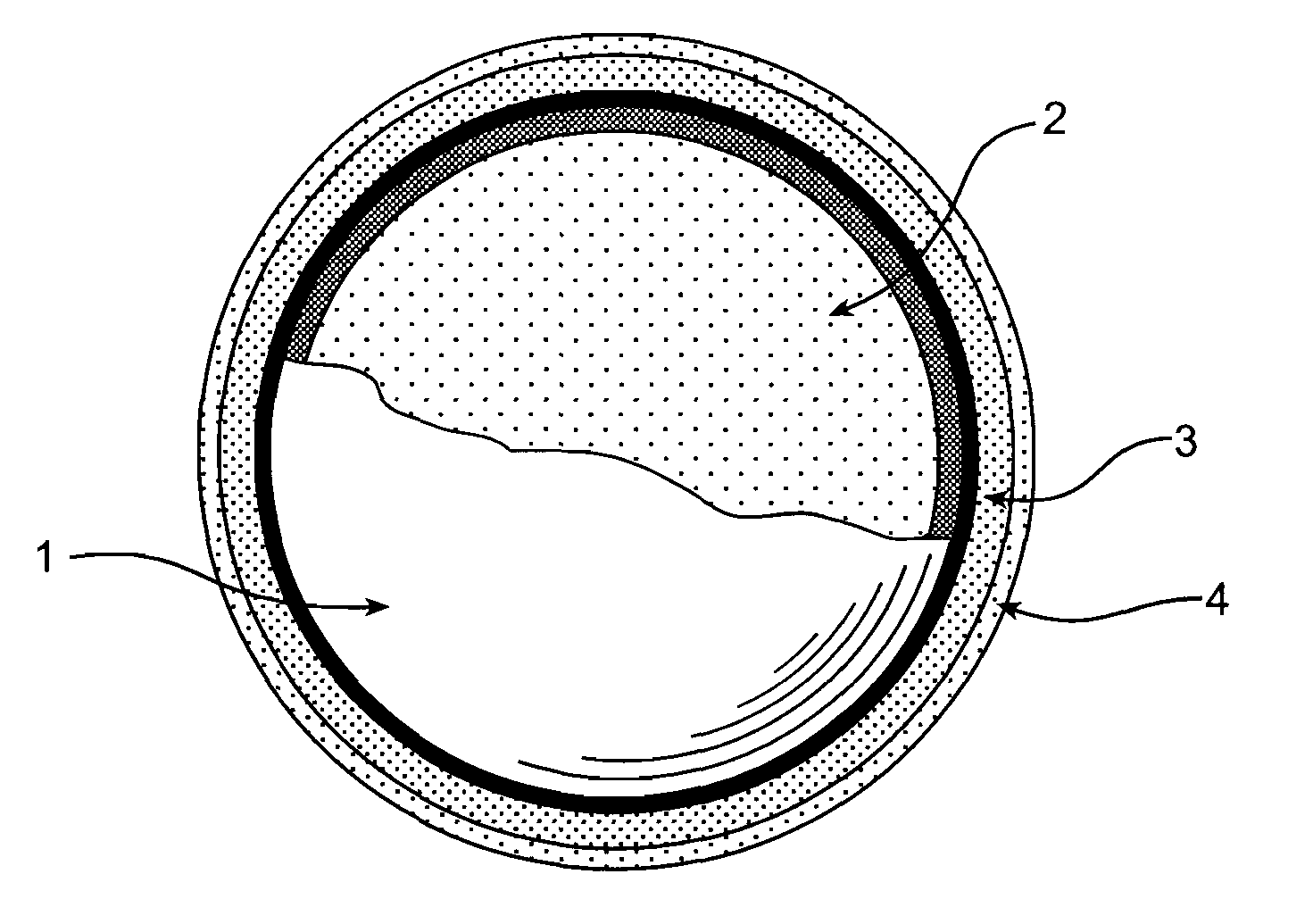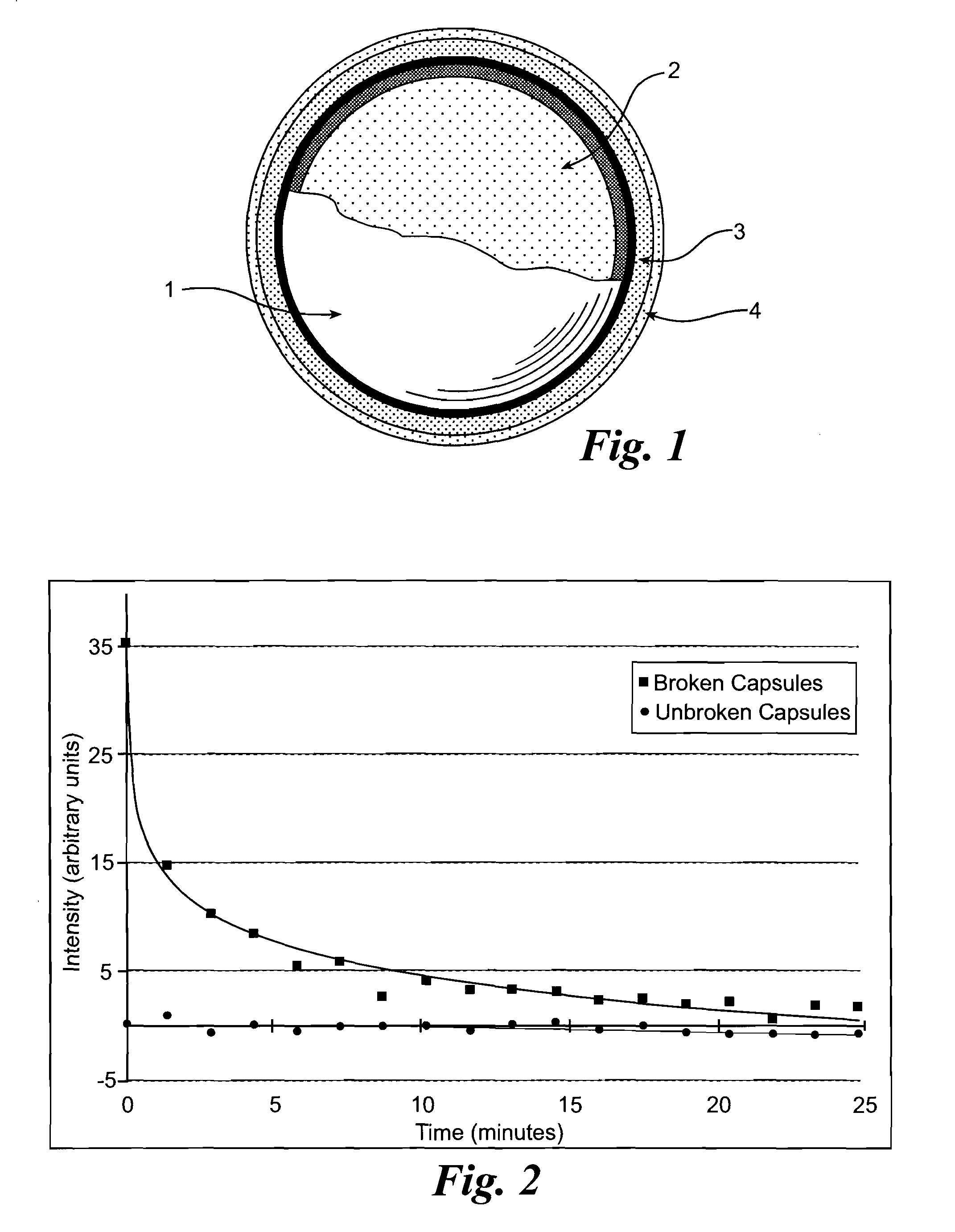One-part, pressure activated chemiluminescent material
a technology of chemiluminescent materials and pressure activated chemiluminescent materials, which is applied in the direction of luminescence, other chemical processes, lighting and heating apparatus, etc., can solve the problems of limited applications requiring a user-defined reaction volume, lack of control of chemical reaction extent, waste of glowstick contents, etc., to improve system shelf life, reduce waste, and more versatile applications
- Summary
- Abstract
- Description
- Claims
- Application Information
AI Technical Summary
Benefits of technology
Problems solved by technology
Method used
Image
Examples
example 1
Microencapsulation by “Complex Coacervation”
[0030]Prepare five solutions one hour before the encapsulation process:
[0031]Solution A: Dissolve 2.73 g gelatin (type A from porcine skin, 300 bloom) in 30 mL distilled water.
[0032]Solution B: Dissolve 50 mg of violanthrone-79 in 20 mL of dioctyl phthalate at 50° C., under nitrogen.
[0033]Solution C, 27.5 mL distilled water, warmed to 50° C.
[0034]Solution D: Dissolve 263 mg sodium hexa-metaphosphate in 5 mL distilled water.
[0035]Solution E: Dilute 5 mL glutaraldehyde (25% in water) with 10 mL of distilled water.
[0036]Procedure: Stir the entire amount of gelatin solution “A” in a 150 mL beaker with a 2-inch, 4-blade mechanical stirrer at 250 rpm. Heat to 50° C. while stirring. Increase the pH of the solution to 8.0 by adding aqueous 10% NaOH solution. Slowly add core solution “B”. Allow to mix for 10 minutes. Ensure the solution returns to 50° C. Add dilution water “C” and 2 drops of 1-octanol to defoam. Add the polyanion solution “D”, and ...
example 2
Microencapsulation by “In-Situ”
[0046]Prepare two solutions in advance:
[0047]Solution I: Dissolve 1.0 g poly(ethylene-alt-maleic anhydride) in 40 mL of distilled water for 16 hours at 50° C.
[0048]Solution J: Dissolve 50 mg of violanthrone-79 in 20 mL of dioctyl phthalate at 50° C., under nitrogen.
[0049]Procedure: In a 150 mL beaker, dissolve 1.250 g of urea, 0.125 g of ammonium chloride and 0.125 g of resorcinol in 50 g of distilled water by mechanically stirring with a 2-inch, 4-blade stirrer at 250 rpm. Once dissolved, add 12.5 mL of solution “I” and then adjust the pH of the mixture to 3.5 using 10% NaOH solution. While stirring, add 15 mL of solution “J” to the beaker and allow the droplets to equilibrate for 10 minutes. Finally, add 3.168 g of 37% formaldehyde in water. Cover the beaker with a double layer of aluminum foil. At a rate of 1° C. / minute, slowly heat the beaker to 55° C., and once at that temperature, continue to heat for an additional 4 hours. Allow to cool, and fil...
example 3
[0052]Using the completed, coated microcapsules as described in Example 1, combine 0.14 g of the capsules with 0.5 mL of poly(ethylene glycol) (Mn=300) until homogenous. No infrared light is observed until the capsules are crushed.
PUM
 Login to view more
Login to view more Abstract
Description
Claims
Application Information
 Login to view more
Login to view more - R&D Engineer
- R&D Manager
- IP Professional
- Industry Leading Data Capabilities
- Powerful AI technology
- Patent DNA Extraction
Browse by: Latest US Patents, China's latest patents, Technical Efficacy Thesaurus, Application Domain, Technology Topic.
© 2024 PatSnap. All rights reserved.Legal|Privacy policy|Modern Slavery Act Transparency Statement|Sitemap


